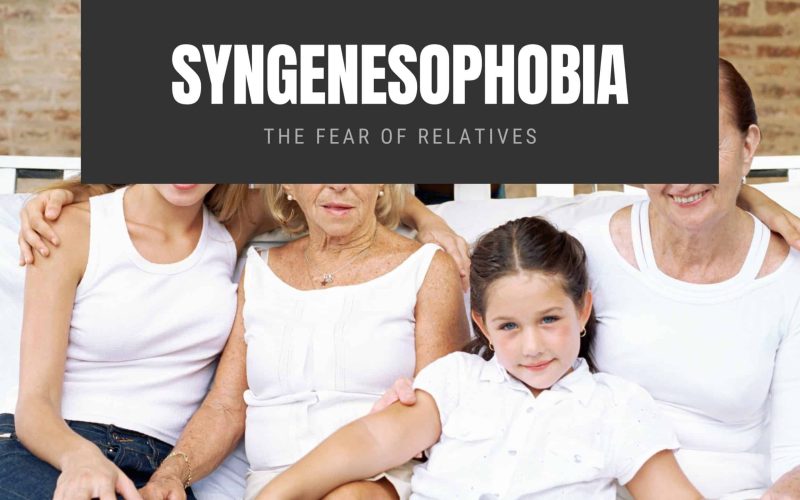Fears are natural, and the effect of fear varies from person to person, just as the cause and object of fear vary.
Syngenesophobia is the intense and irrational fear of relatives. Someone who suffers from this rare condition can expect to deal with discomfort and a very high level of anxiety from the mere thought of relatives, let alone actually being in the same space with them or seeing them.
In fact, the anxiety that people with Syngenesophobia may face can be so intense that these people may even suffer a full-blown panic attack from the thought or sight of a relative.
Although it is not everyone who deals with Syngenesophobia will suffer such an influx of anxiety, the possibility of it occurring is still very plausible nonetheless.
A person who experiences a full-blown panic attack due to syngenesophobia may expect to notice an increased rate of breathing, an increased heart rate, excessive sweating, trembling, muscle tension, and higher blood pressure, among several other symptoms.
Although, as mentioned earlier, not everyone with syngenesophobia will suffer severe panic attacks, it is still very possible to occur as it is a common symptom. Panic attacks will occur most, especially if the person’s symptoms are severe.
Just like other specific phobias, a person who suffers from syngenesophobia may find that they avoid that which they are afraid of.
They may even take this to the extreme by doing all it takes to ensure that they cannot be exposed or come in contact with relatives in any way.
For instance, someone with this condition may refuse to attend family functions or even see their relatives, no matter the situation (i.e., family reunion, wedding, holidays, etc.).
Excessive worrying like this and irrational thinking is possibly one of the leading causes of the mental anguish that people with syngenesophobia live with.
A person with syngenesophobia may actively try to avoid their fear by staying away from family gatherings in an attempt to help reduce their chances of experiencing any anxiety.
However, doing so may cause their symptoms to worsen in the long term because they would also be unknowingly justifying their fear to themselves by deliberately avoiding it.
What Are the Symptoms of Syngenesophobia?
As is the case with almost every other phobia known to man, someone who deals with syngenesophobia can expect to experience anxiety as the most prominent symptom of their fears.
Also, as stated above, the anxiety they deal with may be so intense that it may even cause a full-blown panic attack each time they are exposed to relatives.
Depending on how severe their panic attack is, they may have to be hospitalized. However, this occurrence will vary from person to person and will also depend on many factors.
Furthermore, someone who deals with syngenesophobia may exhibit some avoidance behavior whenever they suspect possible expertise, like exposure to relatives.
Below are some of the more common symptoms of syngenesophobia:
- Constantly deliberately avoiding one’s relatives
- Anxiety at the thought of one’s relatives
- Inability to cope with the anxiety that comes with this phobia
- May experience panic attacks
- Muscle tension, sweating, and shakiness
Possible Causes of Syngenesophobia
There are no selected or identified causes of any phobia, and that includes syngenesophobia. Nevertheless, psychotherapists seem to believe that genetics and a person’s environment may both play highly significant roles in the development of such fears.
For example, suppose a person has a family history of any specific mental illness or various mental illnesses, especially specific phobias or anxiety disorders. In that case, such a person may have a higher chance of dealing with syngenesophobia.
This may be because they have a genetic predisposition to developing any mental illness. If a person were to have that kind of genetics, then all it may require to trigger syngenesophobia could be one bad experience.
Although nobody knows the precise causes of syngenesophobia, the consensus amongst a large percentage of mental health professionals is that both environmental factors and genetics play very important roles in the development of any mental disorder.
So, if a person takes a closer look at these two parameters, it may go a long way to shed some light on the possibility of that person developing syngenesophobia.
Treatments
Just as we have pointed out that there are no definitive causes of any phobia, including syngenesophobia, there are also no specific treatments that are designed especially for this or any other phobia.
Nevertheless, there are still a few different types of treatment methods that can help to greatly improve several symptoms of syngenesophobia.
Below are some of these treatments, including cognitive-behavioral therapy (CBT), exposure therapy, and psychiatric medications.
Cognitive-behavioral therapy for syngenesophobia
CBT is one prevalent method of treatment that can be used to help those suffering from obsessive-compulsive disorder (OCD) and generalized anxiety disorder (GAD), among many other conditions.
Moreover, this treatment method may also be useful for the treatment of people who also suffer from phobias like syngenesophobia.
CBT works by having the therapist help patients discover why they behave, think, and feel the way they do regarding a specific concern or fear.
Someone who has syngenesophobia and chooses to partake in CBT can expect to find out why it is that they think or feel the way they do about their relatives, among other things.
Understanding things that may be a contributing factor to the fears they have may help people with syngenesophobia to deliberately take a more pragmatic approach when they think about their fear of relatives.
Exposure therapy
Exposure therapy is one other very common method of treatment for those who suffer from phobias.
Exposure therapy functions by having the therapist expose the patient to the object of their fear gradually over a specific period.
With regards to the fear of relatives or syngenesophobia, the therapist may begin by exposing the patient to pictures of some of their relatives.
Hence, they begin to get comfortable looking at those pictures and eventually have the relatives visit the patient physically or have the patient visit with their relatives physically, insofar as they are willing to do so.
All of this would be in an attempt to gradually desensitize the patient to their fear of relatives by repetitively exposing them to these relatives.
Theoretically, this treatment process works based on lessening or eliminating fear by exposing patients to their feared objects frequently and safely.
If you think you may be suffering from syngenesophobia or if you have noticed some or all of the symptoms that we have described in this article, then you must talk to your doctor as soon as possible.
This is so that you can get a proper diagnosis and treatment. Upon consulting your doctor, you may be referred to a mental health professional like a psychologist or a psychiatrist for further treatment.
We hope this article has been helpful to you. Kindly leave a comment below and also share.








